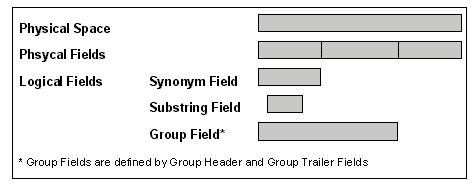Chapter 2-1: Data Dictionary Overview |
Logical Fields Substrings, synonyms, and group fields (as defined by group header and optional group trailer fields) are logical fields. They require no separate (new) allocation of physical space. They occupy space, or a portion of space, that is occupied by the field they reference. In other words, logical fields redefine or share the physical space that is occupied by a physical field (see the figure below).
Physical Space Requirements Logical fields draw a subset of basic attributes from one or more physical fields. The full set of attributes for a logical field is actually a combination of those established by physical fields, APPX defaults, and you. A logical field draws certain attributes from a physical field when the dictionary is processed. At the same time, it assumes additional attributes established by APPX or by specifications you enter for a logical field itself. The specific source of each attribute depends upon the type of logical field. |
Application Design Manual "Powered by Appx Software"121 ©2006 By APPX Software, Inc. All Rights Reserved |
